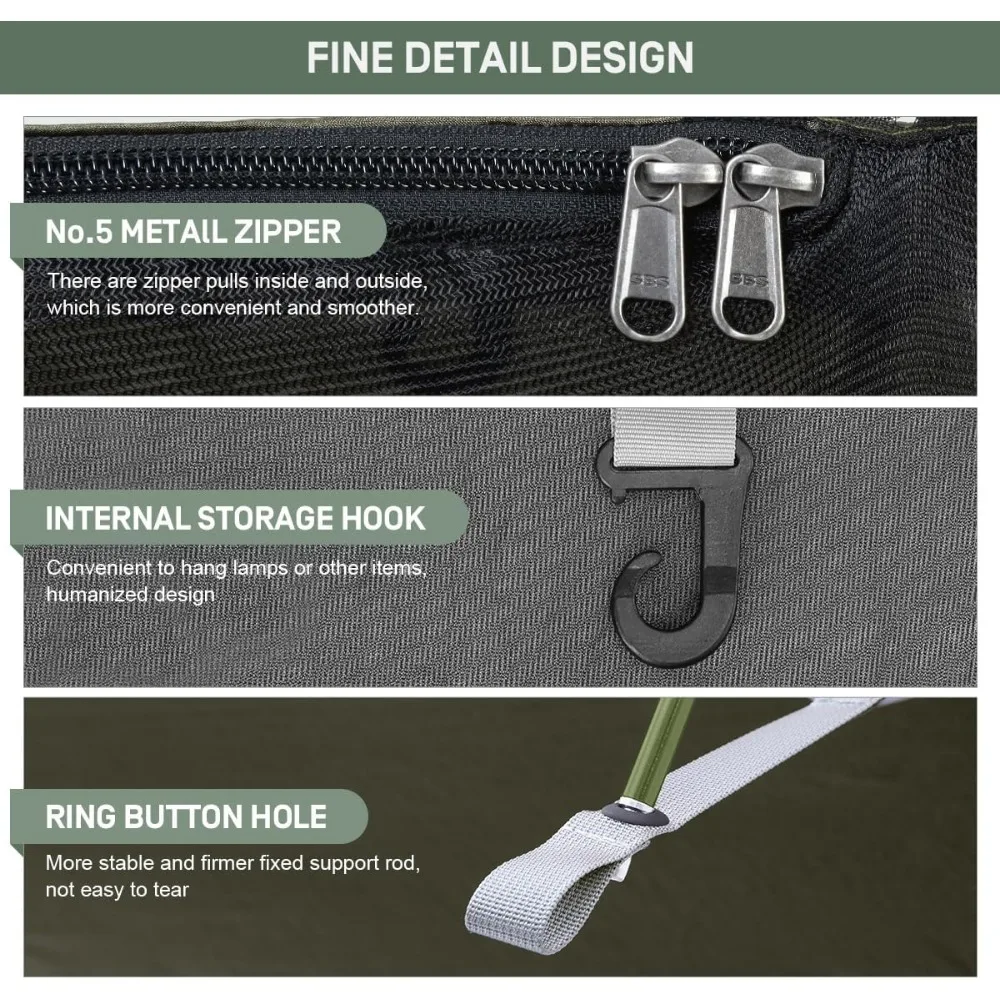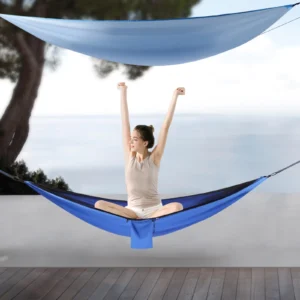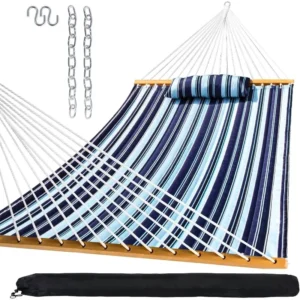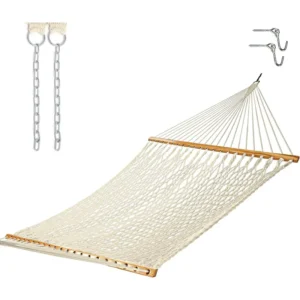Introduction
Hammocks have evolved from simple lounging options to specialized gear designed for specific environments and uses. Understanding the differences between camping and home hammocks isn’t just about terminology—it’s essential for your comfort, safety, and overall experience.
Choosing the wrong hammock type can lead to frustrating outcomes: imagine bringing a bulky home hammock on a backpacking trip, or trying to relax in a narrow camping hammock during a backyard gathering. These mismatches not only affect enjoyment but can create safety concerns and waste your investment.
At Outside Luxe, we’ve seen how proper hammock selection enhances relaxation experiences. The key differences between camping and home hammocks involve:
- Material construction and durability
- Weight and portability considerations
- Suspension systems and setup requirements
- Comfort design philosophy
Remember that both hammock types excel at their intended purposes. The ideal choice depends on where and how you plan to use your hammock, not which is inherently “better.” Finding the right fit for your indoor-outdoor hammock placement will ensure years of enjoyable use.
What Are Camping Hammocks?
Camping hammocks are specialized outdoor sleeping systems designed primarily for adventurers who need lightweight, portable options for overnight trips in nature. These technical hammocks have evolved significantly from traditional designs, transforming into sophisticated gear for backpackers, hikers, and outdoor enthusiasts.
Key characteristics of camping hammocks include:
- Lightweight construction (typically 16-32 oz/454-907g)
- Compact packability (often compressing to the size of a water bottle)
- Durable technical fabrics like 70D ripstop nylon
- High weight capacity despite minimal materials
- Weather-resistant properties and quick-drying capabilities
Unlike home hammocks, camping models are designed as part of a comprehensive “sleep system” rather than standalone items. This system approach helps adventurers stay comfortable in varying conditions while minimizing pack weight and volume.
The growing popularity of camping hammocks among backpackers stems from their versatility in different terrains, especially where flat ground for tent setup is limited. Many outdoor enthusiasts appreciate the connection to nature that camping hammocks with integrated bug protection provide compared to traditional tents.
What Are Home Hammocks?
Home hammocks represent the classic relaxation option most people envision when thinking about hammocks. These comfort-focused designs prioritize lounging enjoyment, aesthetic appeal, and integration with home or garden environments.
Home hammocks come in several distinct styles:
- Spreader bar hammocks: Feature wooden bars that keep the hammock fabric flat and open
- Brazilian hammocks: Woven fabric designs without spreader bars that create a cocoon-like experience
- Rope hammocks: Traditional latticed designs with an open, airy feel
- Quilted hammocks: Padded for extra comfort with decorative fabric options
Unlike their camping counterparts, home hammocks emphasize comfort and visual appeal over portability. They typically feature heavier, more substantial materials that enhance the lounging experience and complement outdoor living spaces.
These hammocks are designed to become semi-permanent fixtures in backyards, patios, porches, or even indoor spaces. Many users pair them with hammocks and stands for versatile placement options when trees or mounting points aren’t available.
Home hammocks often feature wider dimensions, decorative elements, and design flourishes that would be impractical for camping models. They’re intended to create inviting relaxation zones that enhance outdoor living areas while providing maximum comfort for extended leisure time.
Material and Construction Differences
The materials and construction techniques for camping and home hammocks differ dramatically based on their intended uses:
| Feature | Camping Hammocks | Home Hammocks |
|---|---|---|
| Primary Materials | Ripstop nylon, polyester | Cotton, polyester blends, rope |
| Weight Focus | Ultralight (1-2 lbs) | Comfort (5-15+ lbs) |
| Stitching | Reinforced, lightweight | Decorative, comfort-focused |
| Weather Resistance | High (quick-dry, UV protected) | Variable (often limited) |
| Texture | Smooth, technical feel | Soft, textured comfort |
Camping hammocks utilize technical synthetic fabrics that prioritize strength-to-weight ratio. Materials like 70D ripstop nylon provide exceptional durability while remaining lightweight and packable. These fabrics typically feature special treatments for water resistance, UV protection, and quick-drying capabilities—all essential for unpredictable outdoor conditions.
Home hammocks, by contrast, emphasize tactile comfort and visual appeal. Cotton and cotton-blend fabrics create a soft, breathable surface ideal for lounging, while rope designs offer classic aesthetics. The fabrication techniques often incorporate decorative elements like fringe, tassels, or colorful patterns that would add unnecessary weight to camping models.
The stitching approaches also differ significantly. Camping hammocks use minimal, precisely engineered seams focused on maximum strength with minimal material, while home hammocks often feature more elaborate, comfort-oriented construction. Understanding whether it’s okay to leave hammocks outside depends largely on these material differences and how they respond to environmental exposure.
Weight, Portability and Packability
The weight and portability differences between camping and home hammocks are among the most significant practical distinctions:
Camping hammocks are engineered for maximum portability:
* Weight range: Typically 16-32 oz (454-907g)
* Packed size: Often comparable to a water bottle or softball
* Integrated stuff sacks for compressed storage
* Designed to fit easily inside a backpack
* Lightweight supporting components (carabiners, suspension)
Home hammocks prioritize comfort over portability:
* Weight range: Often 5-15+ pounds (2.3-6.8+ kg)
* Size when folded: Significantly larger, rarely designed to pack small
* May require separate storage bags if portable at all
* Too bulky for backpacking or hiking
* Heavier supporting components (chains, stands, thick ropes)
This weight disparity reflects their intended uses. A camping hammock needs to be carried long distances alongside other gear, making every ounce important. Home hammocks are typically set up once and left in position, making weight largely irrelevant compared to comfort features.
For travelers needing maximum versatility, portable hammocks with stands offer a middle ground, combining reasonable portability with stand-alone capability, though they’re still considerably heavier than dedicated camping options.
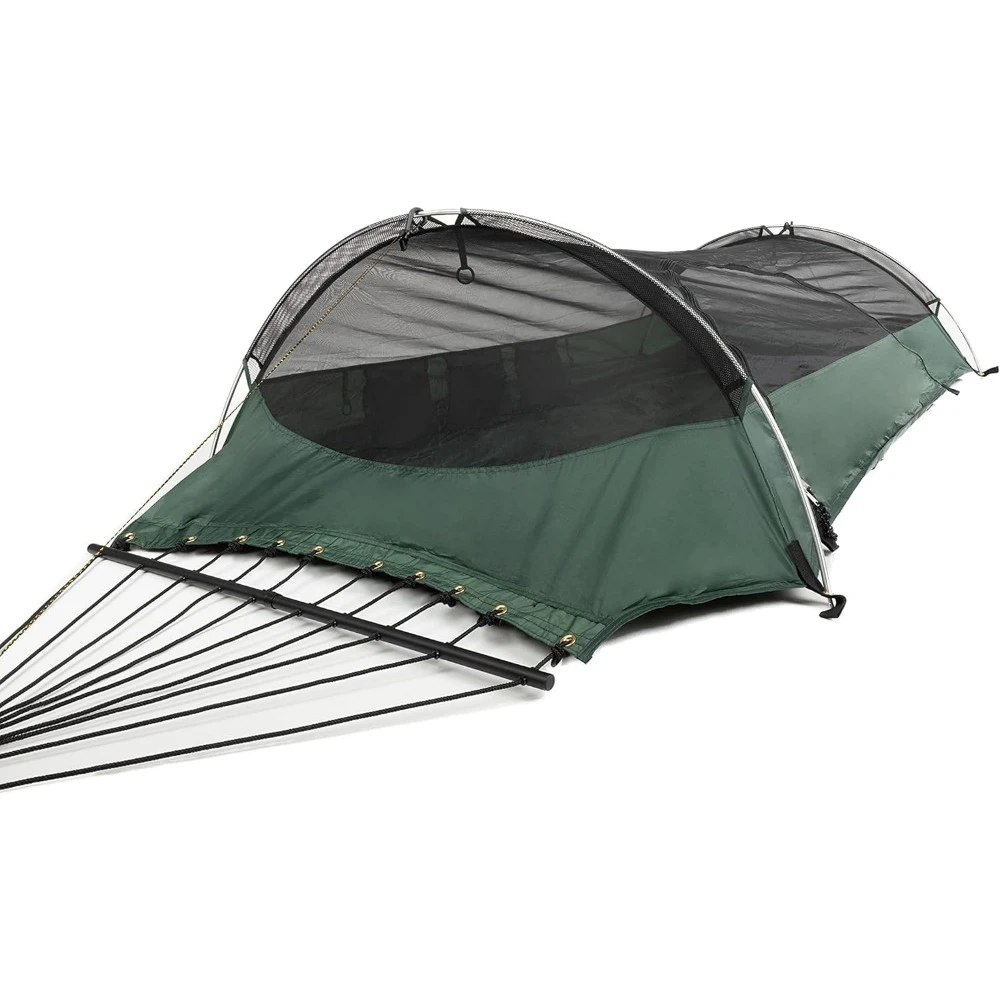
Suspension Systems Compared
The suspension systems for camping and home hammocks reflect their different purposes and environments:
Camping Hammock Suspension:
* Tree straps (typically 0.75-1.5 inches wide for tree protection)
* Lightweight adjusters (whoopie slings, webbing, buckles)
* Minimal, ultralight carabiners or toggles
* Quick-adjust systems for variable distances
* Leave No Trace-friendly designs to protect trees
* Weight capacity typically 275-400 lbs (125-181 kg)
Home Hammock Suspension:
* Thick ropes, chains, or S-hooks for permanent mounting
* Heavy-duty hardware for semi-permanent installation
* Often includes dedicated stands with specific dimensions
* Limited adjustment capability once installed
* Designed for consistent, repeated use in one location
* Weight capacity often 450-600+ lbs (204-272+ kg)
Camping hammock suspension prioritizes versatility, as users must adapt to whatever trees or anchor points are available. They feature quick-adjust mechanisms that allow for hanging between anchor points of varying distances, typically 10-20 feet (3-6 meters) apart. The best systems distribute weight to protect tree bark and prevent environmental damage.
Home hammock suspension assumes consistent, known anchor points. Whether attached to posts, dedicated stands, or wall mounts, these systems emphasize stability and long-term durability over adaptability. Understanding proper hammock installation requirements and safety guidelines is essential regardless of which type you choose.
The suspension difference significantly impacts where and how each hammock type can be used. Camping hammocks can adapt to uneven ground, varying tree distances, and unusual spaces. Home hammocks generally require flat, measured spaces with consistent dimensions.
Required Accessories for Each Type
The accessory ecosystems for camping and home hammocks differ substantially based on their intended use environments:
Camping Hammock Accessories:
* Rain tarps/flies (for weather protection)
* Bug nets (for insect protection)
* Underquilts (for bottom insulation)
* Top quilts (specialized sleeping bags)
* Tree-friendly suspension straps
* Ridgelines for gear hanging and shape control
Home Hammock Accessories:
* Stands (for placement flexibility)
* Decorative pillows and padding
* Weather covers (for seasonal storage)
* Drink holders or side tables
* Decorative hanging hardware
* Spreader bars (for certain styles)
Camping hammocks function as systems rather than standalone products. The core hammock is just one component in a complete shelter solution. Temperature regulation is particularly critical for camping hammocks—without proper insulation underneath, even summer nights can become uncomfortably cold due to convective heat loss.
Home hammocks typically work as complete, standalone products with accessories focused on enhancing comfort rather than addressing survival needs. Their accessories tend to be decorative or convenience-oriented rather than functional necessities.
This accessory difference significantly impacts overall cost considerations. While a basic camping hammock might cost less initially than a home model with a stand, the complete camping system with weather protection and insulation can represent a substantial investment. For comprehensive options, consider exploring complete camping hammock systems that include essential accessories in one package.
Comfort: Ergonomics vs Relaxation
Camping and home hammocks approach comfort from fundamentally different perspectives:
Camping Hammock Comfort:
* Focused on ergonomic sleeping positions
* Requires diagonal laying for flat positioning
* Narrower width (typically 4-5.5 feet/1.2-1.7 meters)
* Designed for practical rest and recovery
* Emphasizes minimal pressure points for sleep
Home Hammock Comfort:
* Designed for lounging and relaxation
* Often uses spreader bars for open, flat surfaces
* Wider dimensions (typically 5-8 feet/1.5-2.4 meters)
* Created for leisurely enjoyment and social use
* Emphasizes luxurious feel and spaciousness
Camping hammocks require specific techniques to achieve comfortable sleeping positions. The diagonal lay—positioning your body at roughly a 30-degree angle from the centerline—creates a flatter, more ergonomic surface. Without this technique, users experience the “banana effect” where their bodies curve uncomfortably, making quality sleep difficult.
Home hammocks, particularly those with spreader bars, create naturally flatter surfaces that don’t require special techniques. They’re designed for casual relaxation rather than overnight sleeping, with dimensions and fabric tension that accommodate various lounging positions.
The fabric tension also differs significantly between types. Camping hammocks typically feature adjustable tension to create the optimal sleeping surface, while home hammocks—especially spreader bar designs—maintain consistent tension for predictable comfort. For a comprehensive understanding of these differences, our guide on indoor versus outdoor hammocks provides detailed comparisons.
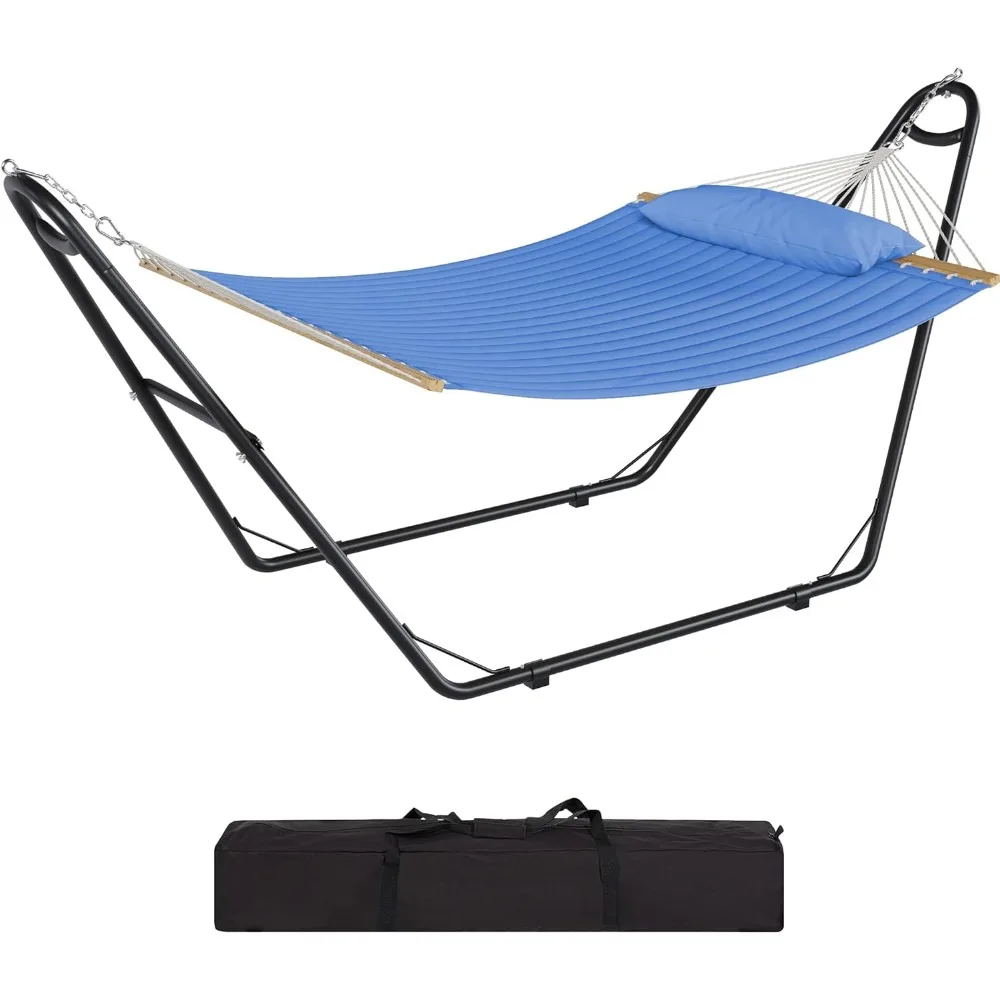
Weather Resistance and Durability
Weather resistance capabilities vary dramatically between camping and home hammocks:
Camping Hammock Weather Resistance:
* High UV resistance ratings (2000+ hours without degradation)
* Quick-drying synthetic materials (typically dry in 15-30 minutes)
* Resistance to mold and mildew
* Often treated with DWR (Durable Water Repellent) coatings
* Designed for exposure to varied elements
Home Hammock Weather Resistance:
* Variable UV protection (cotton options particularly vulnerable)
* Slower drying times (several hours for thick cotton)
* May require regular maintenance to prevent mildew
* Limited water resistance without additional treatment
* Designed primarily for fair weather use
Camping hammocks are engineered to withstand challenging outdoor conditions. Their synthetic materials resist degradation from sun exposure, shed water efficiently, and dry quickly when wet. Many feature reinforced stitching at stress points and ripstop fabrics that prevent small tears from expanding.
Home hammocks, particularly natural fiber options, require more protection from the elements. Extended exposure to moisture can lead to mildew development, while UV radiation can weaken fibers over time. Many home hammocks need seasonal storage or protective covers when not in use.
Proper care significantly impacts longevity for both types. While camping hammocks can generally handle more environmental stress, they still require appropriate cleaning and storage. Understanding indoor and outdoor hammock safety guidelines helps protect both your hammock and yourself from weather-related hazards.
The durability differences directly impact how and where each hammock type can be used. Camping hammocks offer reliable performance in variable conditions, while home hammocks deliver superior comfort in controlled environments.
Setup and Takedown Comparison
The setup and takedown processes reflect the different design philosophies behind camping and home hammocks:
Camping Hammock Setup:
* Average time: 2-5 minutes (hammock only), 5-15 minutes (full system)
* Adaptable to varying anchor points and distances
* Requires learning proper suspension techniques
* Designed for frequent assembly/disassembly
* Adjustments critical for comfort and safety
Home Hammock Setup:
* Initial setup: 15-30+ minutes (particularly with stands)
* Designed for semi-permanent installation
* Often requires tools and multiple people for stand assembly
* Minimal adjustment needed after initial setup
* Intended to remain in position for extended periods
Camping hammocks feature intuitive suspension systems designed for quick deployment in varying environments. Their setup process emphasizes adaptability—users must assess trees or anchor points, determine appropriate hang angles, and adjust suspension for optimal comfort. This flexibility allows setup in diverse locations but requires some practice to master.
Home hammocks, especially those with stands, involve more intensive initial assembly but minimal ongoing effort. Once positioned correctly, they typically remain in place for an entire season or permanently. The setup process focuses on stability and durability rather than adaptability.
Environmental adaptability represents another key difference. Camping hammocks can accommodate uneven terrain, varying tree distances, and limited space. Home hammocks generally require flat, consistent surfaces with adequate clearance. Finding optimal setup locations for different hammock types significantly impacts your overall experience with either style.
Comprehensive Comparison Table
| Feature | Camping Hammocks | Home Hammocks |
|---|---|---|
| Primary Purpose | Sleeping during outdoor adventures | Lounging and relaxation at home |
| Materials | Lightweight synthetics (nylon, polyester) | Cotton, rope, heavy-duty synthetics |
| Weight | 16-32 oz (454-907g) | 5-15+ lbs (2.3-6.8+ kg) |
| Packed Size | Water bottle sized | Bulky, not designed to pack small |
| Suspension | Tree straps, lightweight adjustable systems | Chains, ropes, often with stands |
| Essential Accessories | Tarps, bug nets, insulation | Pillows, stands, decorative elements |
| Weather Resistance | High (quick-dry, UV protected) | Limited (often requires protection) |
| Comfort Focus | Ergonomic sleeping positions | Luxurious lounging experience |
| Setup Time | 2-15 minutes (depends on components) | 15-30+ minutes (initial setup) |
| Durability Rating | 4/5 for weight class | 3/5 for outdoor exposure |
| Aesthetic Appeal | 2/5 (function over form) | 5/5 (design emphasis) |
| Versatility Rating | 5/5 (multiple environments) | 2/5 (specific environments) |
| Cost Range | $30-200+ (hammock only), $100-400+ (system) | $50-300+ (depends on materials/stand) |
This comparison highlights how each hammock type excels in its intended environment while facing limitations outside its designed purpose. Camping hammocks maximize functionality, portability, and adaptability at the expense of luxury and lounge comfort. Home hammocks prioritize relaxation experience and aesthetic appeal at the cost of portability and versatility.
For specialized backpacking applications, the considerations become even more technical. Our backpacking compact hammock guide explores these nuances in greater detail, especially for weight-conscious adventurers.
Can You Use a Camping Hammock at Home?
Using a camping hammock at home is entirely feasible and offers several advantages:
Camping hammocks bring practical benefits to home settings, including exceptional durability, quick setup once you learn the technique, and versatility for different spaces. Their lightweight design makes them easy to move between locations, whether indoors or in your backyard.
However, camping hammocks do have limitations in home environments. Their narrower width and technical fabrics provide less luxurious lounging comfort than dedicated home models. The utilitarian appearance may clash with carefully designed outdoor living spaces, and most require trees or mounting hardware rather than free-standing capability.
For successful home use of camping hammocks:
* Consider purchasing a compatible stand designed for camping hammocks
* Add comfort layers like blankets or thin mattresses for lounging
* Choose models with more attractive color options for visual appeal
* Use wider (double) camping hammocks for more comfortable lounging
Camping hammocks work particularly well in homes with limited storage space, for guests who need temporary sleeping options, or in perfectly placed hammock locations around your home and garden where their quick setup and takedown is advantageous.
Can You Use a Home Hammock for Camping?
Using home hammocks for camping presents significant challenges that make them impractical for most outdoor adventures:
The primary limitations stem from fundamental design differences. Home hammocks typically weigh 3-5 times more than camping models, making them prohibitively heavy for backpacking. Their bulky size when packed consumes valuable backpack space, and most lack the integrated weather protection essential for outdoor sleeping.
The suspension systems for home hammocks present another major obstacle. They often require specific hanging distances and hardware not readily available in wilderness settings. The decorative ropes or chains commonly used with home hammocks can also damage tree bark, violating Leave No Trace principles.
Home hammocks might work in very limited camping scenarios:
* Car camping where vehicle space isn’t limited
* Established campgrounds with perfect tree spacing
* Guaranteed fair weather conditions
* Short-duration trips where comfort outweighs practicality
For most camping situations, choosing ultralight camping hammock sets specifically designed for outdoor use provides a dramatically better experience with appropriate weather protection, proper insulation, and practical weight.
A-Frame Stand Hammock Sets, Swinging Hammock Chair Sets
$154.62 Select options This product has multiple variants. The options may be chosen on the product pageCamping Hammock Sets with Bug Net, Ultralight Camping Hammock Sets
$139.72 Select options This product has multiple variants. The options may be chosen on the product pageClassic Wooden Stand Hammock Sets, Heavy Duty Hammock Sets
$1,061.68 Select options This product has multiple variants. The options may be chosen on the product pageHammock Sets with Canopy, Heavy Duty Hammock Sets
$286.31 Select options This product has multiple variants. The options may be chosen on the product pageDouble / Two Person Hammock Sets, Rope Hammock Sets
Double Traditional Cotton Rope Hammock with Extension Chains – 450 lbs Capacity for Backyard & Patio$292.98 Select options This product has multiple variants. The options may be chosen on the product page
How to Choose the Right Hammock Type for Your Needs
Selecting the ideal hammock type requires honest assessment of your intended use and environment:
Start by identifying your primary purpose:
* For backpacking and wilderness camping: Choose a camping hammock
* For backyard relaxation and home use: Select a home hammock
* For car camping with minimal hiking: Consider a crossover option
Evaluate your environment:
* Do you have appropriate trees (10-15 feet apart, 6+ inches diameter)?
* Is a stand more practical for your space?
* Will your hammock be exposed to weather or protected?
* Do you need mobility or will it stay in one location?
Consider your comfort priorities:
* Overnight sleeping requires proper ergonomic support
* Casual lounging benefits from wider dimensions
* Multiple users need appropriate weight capacity
* Temperature considerations affect insulation needs
Budget considerations should include all necessary components:
* Camping hammocks: Include suspension, weather protection, and insulation costs
* Home hammocks: Factor in stand cost if trees aren’t available
For users seeking versatility, certain models bridge the gap between types. Lightweight but comfortable designs with included stands can work in multiple environments, though they rarely perform as well as specialized options in either extreme. Creating the perfect hammock haven depends on matching your specific needs with the right hammock category.
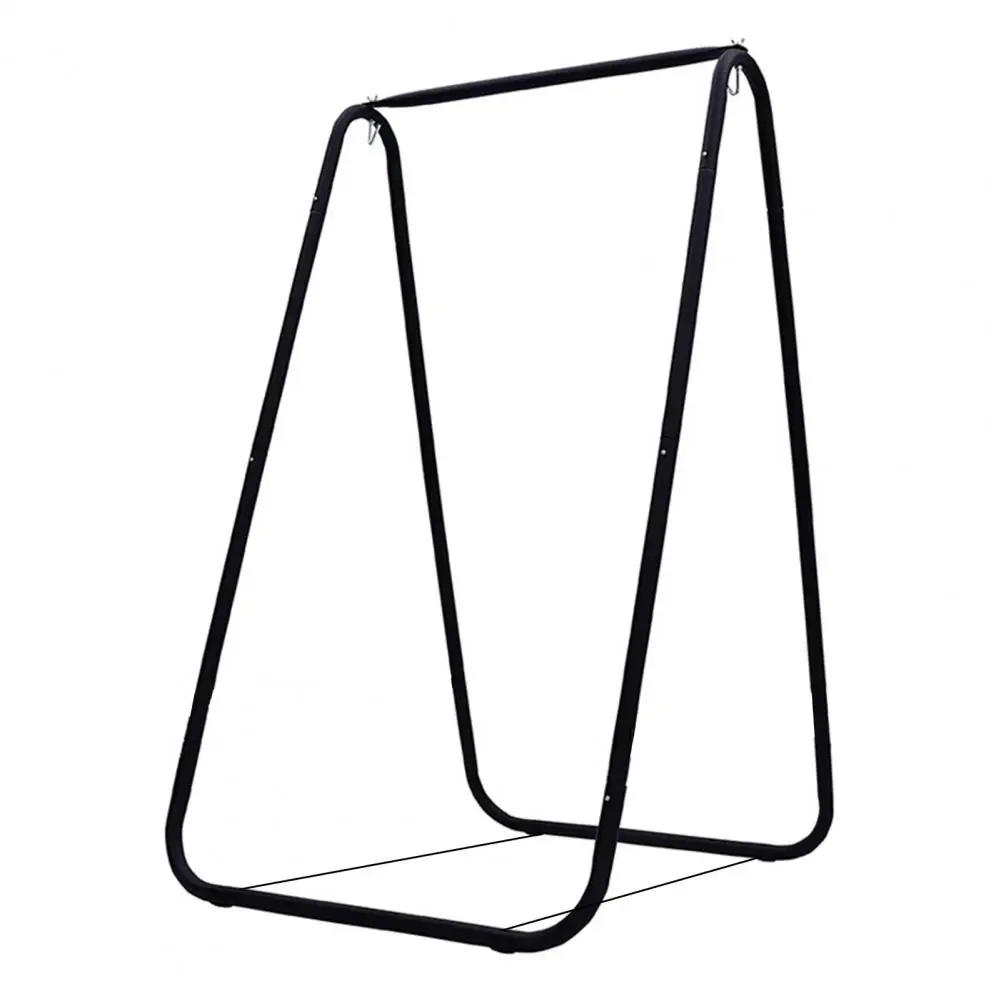
Summary: Making the Right Choice for Your Relaxation Needs
The fundamental differences between camping and home hammocks reflect their specialized purposes rather than overall quality. Camping hammocks excel at providing lightweight, portable sleeping systems for outdoor adventures, while home hammocks create superior lounging experiences in controlled environments.
The key factors separating these hammock types include:
- Materials and construction techniques
- Weight and portability considerations
- Weather resistance capabilities
- Setup requirements and flexibility
- Comfort design philosophy
Understanding these differences helps you make an informed choice that enhances your relaxation experience while avoiding unnecessary expense. Purchasing a high-quality hammock designed specifically for your intended use delivers significantly better results than trying to adapt the wrong type to your needs.
Whether you’re seeking adventure in remote wilderness or creating a backyard oasis, selecting the right hammock type is your first step toward optimal relaxation. With proper selection, your hammock will provide years of enjoyable use in its intended environment.

